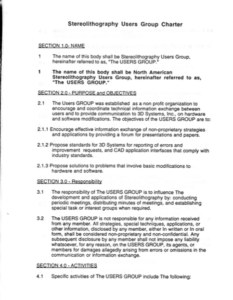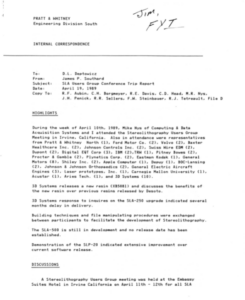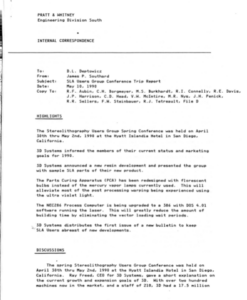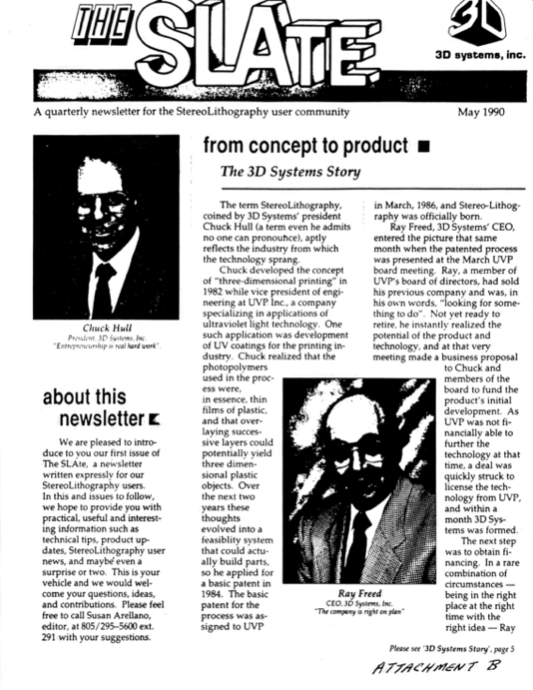AMUG DiNO Jim Harrison, a Technical Sales Representative at nScrypt, has been in the 3D printing industry since its inception. In this series on the history of additive manufacturing, Jim recounts the early days up to the modern era.
In September 29, 1988, the first charter of the Stereolithography Users Group was written. It took us a few months to learn how to say “stereolithography,” and a few more to spell it correctly. The purpose was for a conference for users by users, as well as encourage effective information exchange of non-proprietary strategies and applications by providing a forum for presentations and papers. The goal was also to identify problems and propose solutions or improvements and recommend uniform practices and techniques to be used by the membership. At this time, the technology was so new that we were all learning how to use it and what applications we could use it for.
April, 1989: The First SLA Users Conference
I’ve still got a memo from the 1st SLA Users Conference in 1989. We learned quickly to shorten the name to an acronym—remember we had a lot of military experience. It was very important for us to share our experiences and network. That was the foundation of AMUG: by users for users. It was the first of its kind. We had 50 attendees representing 25 companies.
We still had our SLA-1 Beta 3D Printer at Pratt & Whitney. Back in those days, there wasn’t a computer on everyone’s desk. We had to go to the computer room: a freezing cold, dark dungeon with cipher locks. No internet, just a landline phone and fax. The SLA used a NEC286 computer running with DOS—way before Windows!
The SLA250 System was just announced for release at this meeting. The big news was the newly release resin: guaranteed not to smell like rotten eggs, not as sticky, and featuring better build characteristics. The check was in the mail on that one.
It was also discussed that an SLA machine twice the size was coming out, the SLA500. The demo of the SLP-20 computer was impressive because we were still slicing on the NEC286 that was running the SLA-1 Beta. We had to wait for it to stop slicing before we could start the build. In those days, the computer could only perform 1 task at time. Lucky for us at Pratt & Whitney, Fred Steinbauer acquired the SLP-20 on the rouse of doing a study he completed.
October, 1989: 2nd SLA User’s Conference
In 1989, Pratt & Whitney sponsored the second annual SLA User’s Conference at the EPCOT Living Seas Conference Center in Orlando, FL—very cool meeting rooms. Of course, Fred Steinbauer and Jim Southard went, while I ran the SLA back at home.
3D Systems was silent about the SLA-500 that they mentioned months before. The crowd was not so silent. After the hype and excitement about the SLA500, the system failed to be released. Once again, the check was in the mail.
This event was more about the build parameters. There was a new beam-width compensator feature! Before, we had to manually compensate in the CAD for the beam and shrink factors. That did not work so well.
By this conference, we were just getting manuals for the System. Believe it or not, but at this time there were 12 service bureaus started up but only a few had SLA Systems.
May, 1990: 3rd SLA Users Group Conference
By 1990 SLA Users Group Conference, the SLA machines’ PCA featured mercury vapor lamps that were being upgraded to UV florescent lamps. I really did not like that mercury vapor lamp system because it never really cured the parts properly. I would have to take them outside into the Florida sun to complete the cure.
3D Systems also announced a computer upgrade from NEC286 to NEC386—that’s a 20MHZ processor and 80MB hard drive, and MS DOS 4.01 software at a cost of $10,000. And you think your internet is slow? We didn’t have internet at the time. So, we complained about slow computers!
That year’s event included the first iteration of the “Parts Fair,” now known as the “Technical Competition.” We had five resin manufactures: Ciba Geigy, Loctite, DuPont, Desoto, and Allied Signal Chemicals. A new resin was being released that limited the amount of bubbles in the vat. That was a big problem that created very long wait times, added minutes to each layer.
Also, SLAte, 3D Systems first newsletter, was born. This was a monthly publication to be distributed to Users. It was going to help us communicate new advances between conferences. The first page discussed the very young history of 3D Systems. Other happenings featured included the first European Users Group and the first tech tips. There was a good article about AMP and their SLA-1 Beta machine. It also mentioned 3D Systems’ opening of a Florida office in Orlando. We at the Pratt & Whitney team thought, “what were they thinking?” We had the only machine in the state, and it was in Palm Beach – three hours away.
Subscribe to Our Email Newsletter
Stay up-to-date on all the latest news from the 3D printing industry and receive information and offers from third party vendors.
You May Also Like
Profiling a Construction 3D Printing Pioneer: US Army Corps of Engineers’ Megan Kreiger
The world of construction 3D printing is still so new that the true experts can probably be counted on two hands. Among them is Megan Kreiger, Portfolio Manager of Additive...
US Army Corps of Engineers Taps Lincoln Electric & Eaton for Largest 3D Printed US Civil Works Part
The Soo Locks sit on the US-Canadian border, enabling maritime travel between Lake Superior and Lake Huron, from which ships can reach the rest of the Great Lakes. Crafts carrying...
Construction 3D Printing CEO Reflects on Being Female in Construction
Natalie Wadley, CEO of ChangeMaker3D, could hear the words of her daughter sitting next to her resounding in her head. “Mum, MUM, you’ve won!” Wadley had just won the prestigious...
1Print to Commercialize 3D Printed Coastal Resilience Solutions
1Print, a company that specializes in deploying additive construction (AC) for infrastructure projects, has entered an agreement with the University of Miami (UM) to accelerate commercialization of the SEAHIVE shoreline...


































